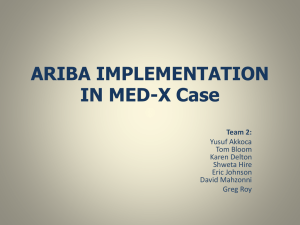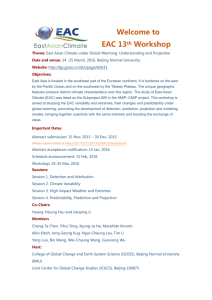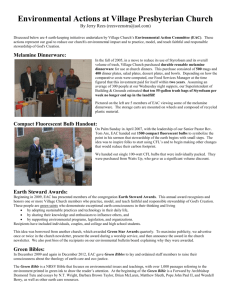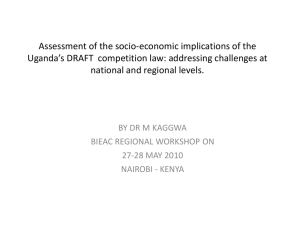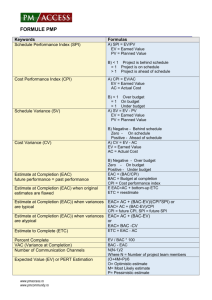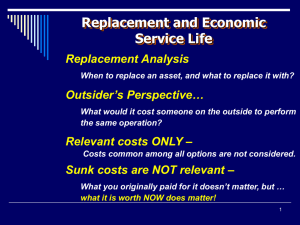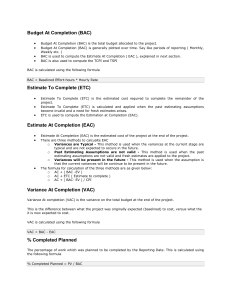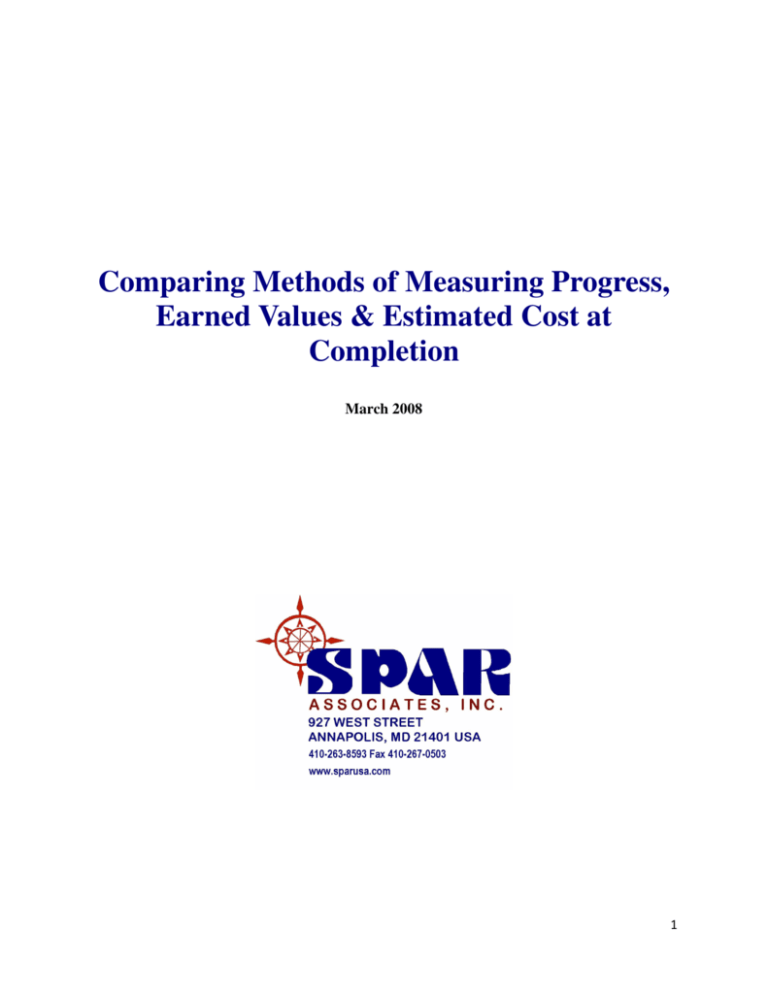
Comparing Methods of Measuring Progress,
Earned Values & Estimated Cost at
Completion
March 2008
1
PERCEPTION is a registered trademark of SPAR Associates, Inc. ESTI-MATE, MAT-PAC, WORK-PAC,
and PERT-PAC are trademarks of SPAR.
PERCEPTION®
Trade Secrets and Proprietary Properties
Of
SPAR Associates, Inc.
Annapolis, MD 21401
2
NOTICE
The information contained in this document is subject to change without notice.
SPAR ASSOCIATES, INC. MAKES NO WARRANTY OF ANY KIND WITH REGARD TO THIS
MATERIAL, INCLUDING, BUT NOT LIMITED TO, THE IMPLIED WARRANTIES OF
MERCHANTABILITY AND FITNESS FOR A PARTICULAR PURPOSE.
SPAR Associates, Inc. shall not be liable for errors contained herein or for incidental or consequential
damages in connection with the furnishing, performance or use of this material.
This document contains proprietary information, which is protected by copyright. All rights reserved. No
part of this document may be photocopied, reproduced or translated to another program language without
prior written consent of SPAR Associates, Inc.
3
CONTENTS
INTRODUCTION ..........................................................................................................................................................5
EARNED VALUE REPORT INFORMATION ....................................................................................................................6
WORK ORDER SIZE & SCHEDULE DURATION ............................................................................................................7
METHODS FOR MEASURING PROGRESS & EARNED VALUE ........................................................................................8
Real Progress........................................................................................................................................................8
Planned Progress..................................................................................................................................................8
Manual Progress...................................................................................................................................................9
Progress = Hours Spent/Budget Hours ................................................................................................................9
Pre-Formulated Earned Value Progress ............................................................................................................10
SPAR Progress....................................................................................................................................................15
METHODS FOR DETERMINING EAC .........................................................................................................................16
EAC Based on Manual Estimate.........................................................................................................................16
EAC Based on Manual Progress ........................................................................................................................16
EAC Based on Pre-Formulated Earned Value Rule ...........................................................................................16
EAC Based on Performance Index......................................................................................................................17
SPAR’s EAC........................................................................................................................................................17
SPAR’s Trend EAC .............................................................................................................................................23
COMPARING EAC METHODS ...................................................................................................................................24
COMPARING PROGRESS MEASUREMENT METHODS .................................................................................................27
GLOSSARY ...............................................................................................................................................................30
4
Introduction
There is general agreement among shipbuilders that intelligent control over basic resources
(engineering, manpower, material, facilities and time) will result in improved ship construction
costs.
The task of estimating costs, planning and scheduling men and materials and then controlling
these resources to maximize production output, while minimizing costs, can be a very difficult
job. These efforts become more complex with the increase in the size of the shipyard
organization and the scope of the yard operations. Modern-day shipbuilding poses no mean
management challenge.
A very basic problem has been work progress visibility, or lack thereof. Without it, management
must operate blindly. Cause and effect relationships become blurred in the midst of daily
shipyard production problems and drain away the capacity to direct production effectively and
economically. Knowing precisely, and in a timely manner, the exact status of men and material,
a responsible management can rectify problems quickly before they become critical. Logical
priorities can then be assigned to solving various impacted areas of production and ideally new
techniques can be developed, simulated and evaluated to improve current yard production
methods. These are the basic goals for what is called a shipbuilder’s earned value system, or
EVMS.
Simply put, EVMS is a tool that allows the shipbuilder to have visibility into technical, cost, and
schedule progress on their contracts. It is a means for measuring progress, for measuring current
cost and schedule variances from plan and for forecasting final costs and schedules at any point
in time of the contract duration.
Most shipyards today have means for accounting and reporting work resources and schedules,
but mostly employ manual methods to obtain EVM information. These methods often have
difficulty producing complete, accurate and timely information. Other shipyards use EVM
software products that are not fully integrated with the daily business transactions of the
shipyard. Transcribing only summary information from the shipyard’s operating systems can
result in the EVM system not recognizing problems that are occurring down in the roots of
operations. Also, making certain simplified assumptions for the EVM data can result in
misleading conclusions.
The quality and timeliness of information determines its value and potential benefit. This applies
to all of the EVM data described below (progress, earned value, etc.). If the EVM data is poor or
even worse incorrect, then it may very well impact management’s ability to make good
decisions. This document describes the good, the bad, and the ugly of EVM data.
5
Earned Value Report Information
One of the core pieces of information necessary for a successful earned value management system is an
accurate assessment of progress. Progress is the basis for measuring earned value (budgeted cost of work
performed, or BCWP) and earned value is the basis for measuring cost and schedule variances.
Without an accurate assessment of progress, the entire credibility of the earned value system is in
jeopardy.
At any point in time over the course of a contract, when the actual cost of work performed, or
ACWP, exceeds the planned earned value (BCWP), there is a cost problem that must be
addressed. This variance indicates that current costs are being expended over budget and might
indicate a problem that uncorrected could jeopardize the success of the project.
Of equal importance to progress and earned value is a forecast of final costs, the estimated costs
at completion, or EAC. An EAC should be developed at regular time intervals through the
course of a contract and compared with the total budget at completion, or BAC. When the EAC
reports being greater than the BAC, or its trend appears to be increasing to a point later in time to
exceed the BAC, contract management should begin is earnest to determine where problems are
occurring and then initiate corrective actions.
Another important measure of progress is how it affects planned schedules. The accumulation of
planned budgets over time is the budgeted cost of work scheduled, or BCWS. When the earned
value, or BCWP, begins to lag the BCWS, the contract management should determine the source
of the schedule problems and implement appropriate work around solutions.
How and when these EVM metrics are determined is critical in whether or not EVM reports are
truly beneficial. Too often EVM systems are adopted simply because they are contract reporting
requirements. As such, management may be less than willing to utilize EVM as an important
management tool. Under these circumstances, the shipyard’s efforts to develop realistic EVM
reports will most likely be compromised. The first sign that EVM has not been fully
implemented within the operations of an organization is when the EVM system is installed as a
tertiary system practically disassociated from the primary business systems of the shipyard.
Then, important EVM parameters, such as earned value and estimates at completion will be
manually estimated, usually without reference to what is actually being performed in production.
6
Work Order Size & Schedule Duration
At the heart of a number of methods for measuring progress and estimating final costs at
completion are work orders. They are the individual work tasks necessary to carry out the
totality of the contract.
It is important that for a well-planned and scheduled project, work orders should be execute in
their proper sequence unless problems arise and work-around plans need to be initiated. Doing
work out of sequence can create problems down schedule with other work orders. It also can
result in non-value added work if they must be interrupted and restarted later to finish.
Measuring progress for a very large project like building a ship can be a daunting and expensive
exercise if done manually. A new construction project requiring one million labor hours can
easily result in approximately 4,000 individual work orders. At any given point in time, a well
planned and executed project may have 15%-20% of these work orders in process. Any more inprocess and either the risk of non-value added hours accumulated against the project or there is
an increase in schedule risk due to too much work being done in parallel.
The size of work orders also is important. Too few with too long durations, and the ability to
accurately measure their progress will be highly questionable. However, too many, and the can
result in problems dealing with too many details especially with regard to time charging by
employees.
For new construction, a good rule of thumb provides an approximate size for work orders to be
250-500 man-hours with schedule durations of about 2-3 weeks. However, level-of-effort
(LOE), like support services, can be bigger in budget and longer in duration. Nevertheless, LOE
work often becomes a cost problem due to their being so non-specific of work accomplished
over time. SPAR’s PERCEPTION1 system provides a special type of work order for LOE called
the time-phased work order. It breaks up the large scope of work into monthly budgeted subtasks that can be measured and reviewed monthly. Time charges are made against the total LOE
work order, and the system determines which monthly sub-task to charge based on the date of
the time charge.
Ship repair projects, on the other hand, more typically are of short schedules and are oriented
around performing smaller tasks. For short order projects, progressing is less necessary than for
longer term new construction projects.
1
AKA Product Orient Design & Construction (“PODAC”) Cost Model
7
Methods for Measuring Progress & Earned Value
There are many different methods for measuring progress of a contract. Popular choices include
manual progress assessments of contract work orders; using various earned value rules, and other
automated methods based on actual cost and schedule performance to planned work orders.
Progress can be measured in a number of different ways. Schedule progress is measured in
terms of calendar time against a planned set of project schedules. Progress also can be measured
in terms of materials fabricated or assembled and even by the amount of money spent. However,
progress as developed for the earned value system more typically is based on labor hours.
Real Progress
Real progress can be tracked as actual labor hours against the final total labor hours expended on
a project. This, however, requires knowing what the final total is. Therefore, real progress can
only be estimated using the estimated hours at completion until the project is 100% finished.
Real Progress = Actual Hours/Total Actual Hours at Completion
= ACWP/EAC
Planned Progress
Planned progress can be measured at any point in time over the course of a project when the
labor hour budgets (work orders) have been time-phased. At any point in time, the cumulative
schedule budget hours to that point in time is called the budgeted cost of work scheduled, or
BCWS (Figure 1).
Figure 1: Time-Phasing Project Labor Hour Budgets
8
At the planned finished date for the project, the BCWS equals the total budget at completion, or
BAC.
Planned Progress = BCWS/BAC
Manual Progress
Manually measuring 20% of these work orders requires 800 individual assessments each w eek.
Another frequent problem is that there is always pressure to report good results. Manual
progress assessments therefore can often be too optimistic such that early cost and schedule
problems cannot be recognized even with earned value reporting methods.
There are two points in time when progress is most certainly known: a) when a work order has
not yet been started and b) when a work order is completed. Sometimes the later status is not
always correctly reported when subsequent reviews reveal that the work is not 100% complete
and additional work is needed to really finish the job. Manual assessments can be largely
subjective, and trying to get too accurate a progress figure can be a waste of valuable time.
Simple figures of 10%, 20%, etc. should be sufficient.
The PERCEPTION system provides entries of manual progress estimates as well as it internally
computed estimates described below.
Progress = Hours Spent/Budget Hours
Measuring progress as the ratio of hours spent to the total hour budget is acceptable, but only if
the work is performed on-budget. But no one will know if the work order is on-budget until the
work order is finished and a final tally of hours spent I compared with its budget. When work is
running significantly over or under budget, the error in this assessment method will be
significant. The over-run situation will leave an assessment of progress in a vacuum when the
actual hours spent exceeds the budget. This means the earned value also is lf in a vacuum, and
management cannot get a good picture of where costs and schedules are going until too late to
initiate any remedies. And the under-run assessment will present an earned value that is less
than it should be credited for the work being performed.
9
Progress Based on Hours Spent
Hours Spent Progress
140%
120%
100%
ACWP Under Budget
80%
ACWP On Budget
60%
ACWP Over Budget
40%
Max Progress
20%
0%
0%
20%
40%
60%
80%
100%
Real Progress
Figure 1: Drawbacks of Progress Based on Hours Spent
Figure 1 above illustrates the drawbacks of using hours spent as the basis for a progress
assessment. In an over-run situation, this method will show better than budgeted progress until
the entire budget has been spent. The reverse occurs for the under-run situation.
Pre-Formulated Earned Value Progress
Pre-formulated progress applies to methods for automating progress assessments. Popular
methods are the 0/100 rule, 25/75 rule, 50/50 rule, the 80/20 rule and others. Except for the
0/100 rule, these methods assume an initial progress merely upon opening the work order, then
assessing the final 100% upon the completion of the work order. Each rule places a different
weight on either beginning a work order or finishing it. The benefit of this method of assessing
progress is that it can be easily automated within an automated earned value management
system. However, there are notable drawbacks.
Figure 2 below shows how various earned value rules would apply to one plan scenario. The
plan is characterized by the distribution of its budget over time (budgeted cost of work
performed, or BCWS), while the rule indicates how earned value will be determined at any given
time. The rule applies to the work orders that are started or completed regardless of whether or
not they in fact are executed according to the plan BCWS.
10
Rule Variations of Earned Value vs Plan BCWS
Percent Earned Value
100%
80%
0/100 Rule
60%
25/75 Rule
50/50 Rule
40%
80/20 Rule
20%
Plan BCWS
0%
0%
20%
40%
60%
80%
100%
Real Progress
Figure 2: Applying Various Earned Value Rules to a Plan
The assumptions for earned values above are that the project is performing exactly as planned
schedule-wise. This is rarely the case, however, as some work orders may be started either
earlier or later than planned. Note that for this condition, the pre-formulated earned values will
always be less than the actual earned values as the plan advances.
Under this plan there can be any number of scenarios for starting and completing work orders.
Figure 3 below illustrates two separate curves under the plan BCWS: one shows the accumulated
budgets of completed work orders; and the other shows the budgets of work in process. If the
project remains on schedule, the difference between the completed budget curve and the planned
BCWS curve represents the budgets of open, in-process work orders. The lower the amount of
in-process work orders, the closer the curve of completed budgets approaches the total planned
BCWS.
11
Percent Total Project Budget
Tracking Budgets of Work Orders In-Process & Work Orders Closed
100%
90%
80%
70%
60%
50%
40%
30%
20%
10%
0%
Planned Budget
Schedule (BCWS)
Total Budget In-Process
Total Budget Completed
0%
20%
40%
60%
80%
100%
Real Progress
Figure 3: Tracking Budgets of Work Orders In-Process and Work Orders Completed (Closed)
But, what happens if the work orders are not performed according to plan. Figure 4 shows how
more work orders are started earlier than planned. The in-process budgets now exceed the early
portion of the planned BCWS.
Percent Total Project Budget
Tracking Budgets of Work Orders In-Process & Work Orders Closed
100%
90%
80%
70%
60%
50%
40%
30%
20%
10%
0%
Planned Budget
Schedule (BCWS)
Total Budget In-Process
Total Budget Completed
0%
20%
40%
60%
80%
100%
Real Progress
Figure 4: Starting Work Orders Earlier Than Planned.
Figure 5 shows the effect of these early starts will have under the various earned value rules.
12
Rule Variations of Earned Value vs Real Earned Value of Plan
Percent Earned Value
100%
80%
0/100 Rule
60%
25/75 Rule
50/50 Rule
40%
80/20 Rule
20%
Plan BCWS
0%
0%
20%
40%
60%
80%
100%
Real Progress
Figure 5: Applying Various Earned Value Rules to a Plan
Figure 5 shows that the earned value rules that place more weight on opening a work order can
exhibit a positive schedule variance, while those rules with lower weights for stating may still
indicate negative schedule variances. Unfortunately, the real schedule status can be blurred
simply by the rule that is applied. These rules also can blur the real status of cost variances in
the same way. Front loading the earned value with earlier starts can indicate a cost savings when
there may very well be a cost problem. The more the weight is placed on the starting of a work
order, the more the disguising of a true cost problem. This exemplifies how the selection of an
earned value rule can be gamed for the early benefit of keeping cost and schedule problems
under cover. Figure 6 illustrates examples of rule errors over the course of the planned schedule.
Variance of Earned Value Rule vs Real Progress Earned Value
20%
Percent Variance
10%
0%
0/100 Rule
-10% 0%
20%
40%
60%
80%
100%
25/75 Rule
-20%
50/50 Rule
-30%
80/20 Rule
-40%
-50%
Real Progress
Figure 6: Range of Errors Introduced from Earned Value Rules
13
The accuracy of an earned value rule will depend on the length of time to start and finish a work
order. The longer the planned work order duration, the less accurate will be the pre-formulated
earned value, regardless of the rule applied. Figure 7 shows an example of earned values
computed over time for work orders of relatively long durations. Figure 8 shows the very same
schedule of the work effort, but the effort has been broken up into much smaller work orders of
smaller schedule direction.
BCWP Measured from Long Duration Work Orders
60
50
BCWP
40
Real BCWP
30
EV50/50
20
EV80/20
EV0/100
10
0
-10
0
2
4
6
8
10
12
Schedule Periods
Figure 7: Measuring Earned Value by Pre-Formulated Rule with Long duration Work Orders
BCWP Measured from Short Duration Work Orders
60
50
Real BCWP
BCWP
40
EV50/50
30
EV80/20
20
EV0/100
10
0
0
2
4
6
8
10
12
Schedule Periods
Figure 8: Measuring Earned Value by Pre-Formulated Rule with Short duration Work Orders
14
SPAR Progress
SPAR’s PERCEPTION will accept manual progress entries and it also has the capability to
measure work progress at any summary level of a project (SWBS, PWBS, COA work center, and
production trade) automatically. The basis for these measurements is the labor hour budget
performance of work orders.
Under most circumstances, PERCEPTION computes progress with the following formula:
P = 100 x (ACWP/EAC),
Where,
•
•
•
"P" is the progress.
"ACWP" is its total accumulated labor hours charged to date (actual cost of work
performed), not including rework, which contributes to no progress.
"EAC" is the current forecast total labor hours at completion.
There are numerous special conditions that require PERCEPTION to make adjustments that are
not apparent in this brief discussion.
Using this simple formula, computing progress is simple if the ACWP and EAC are known.
ACWP is not a problem as it is available directly from time charges. The EAC, however, is not
so easily determined. The following describes the general method used by PERCEPTION to
compute the EAC.
As described below in the discussions determining EAC, SPAR’s progress is almost automatic
and requires very little manual effort. Work orders automatically begin progressing when time
charges against them are entered into the system. When production foreman report back to the
system that work orders are complete, the system determines the EAC and calculates the
progress by the formula above. As described below, SPAR’s EAC is computed based on the
budget performance of completed work orders. The greater the extent of budget over-run, the
system assesses a slower rate of progress for labor hours expended. The greater the extent of
budget under-run, the system assesses a faster rate of progress for labor hours expended.
15
Methods for Determining EAC
There are many different methods for developing EACs. Some are good and provide realistic
estimates that reflect the contract’s actual cost performance. Other methods are not so good and
can even indicate cost conditions that are 100% at odds with actual cost performance.
EAC Based on Manual Estimate
A manually determined EAC is perhaps the least accurate and reliable EAC. Basically, it is
based on very simplistic assumptions and almost always tends to be very optimistic. When a
contract is being reviewed for an EAC, manual estimates will most likely be so subjective that
the project will always be reported as ob budget and on schedule, even if there are cost and
schedule problems behind the scenes. Unfortunately, this is an approach that does not recognize,
at least early enough, that there are problems and that good responsible decisions need to be
made to initiate appropriate remedies before the problems reach crisis proportions.
EAC Based on Manual Progress
An EAC based on a manual progress assessment can be equally unreliable if the progress is
made entirely at a high level of the WBS.
On the other hand, if the progress at the higher level is the result of rolling up manual progress
assessments at the lowest level (the work orders), and if the work orders are of reasonably short
duration as described above, then this method for determining EAC can be quite good.
However, the problem remains that manually progressing work orders is an expensive exercise
for large projects and often are not keep fully updated in time for a full development of an EAC:
EAC = ACWP/Manual Progress
EAC Based on Pre-Formulated Earned Value Rule
An EAC developed using various earned value rules can be far from the mark depending on what
rule is used and how well work orders are opened according the planned schedules. Work orders
opened too early merely to gain earned value will erroneously develop a low EAC, while work
orders left open too long and failing to gain their final earned value credits will result in an EAC
that may be too high.
The EAC calculation for the earned value rules are as follows:
Earned Value = Rule Based BCWP
Progress = BCWP/BAC
EAC = ACWP/Progress
16
EAC Based on Performance Index
A performance index is a ratio that indicates current cost, schedule, or combination variance.
CPI = Cost Performance Index = BCWP/ACWP
SPI = Schedule Performance Index = BCWP/BCWS
TCPI = Combined Cost & Schedule Performance Index = (BAC-BCWP)/(EAC-ACWP)
An EAC developed from a performance index is calculated as follows and applies the index to
estimated remaining work (BAC-BCWP):
EAC = ACWP + (BAC-BCWP)/Index
This EAC is dependent upon the value of earned value, BCWP. If the BCWP is unrealistic, the
resulting EAC also will be unrealistic.
SPAR’s EAC
The PERCEPTION method for forecasting final labor hours (EAC) is to apply some measure of
known budget performance to remaining work. For example, if work orders are overrunning on
an average of 15%, it might be reasonable to assume that the final cost also is likely to be an
overrun as well. The problem however is to determine how much and in what area of the work
breakdown structure (WBS).
It is perhaps not reasonable to expect that after only a few early work orders over-runs that the
entire project should be forecast to suffer exactly the same degree of overrun at the finish2.
While this eventually may be indeed the case, no one typically wishes to predict such dire
consequences when there still remain considerable opportunities to turn things around. We all
tend to be eternal optimists, and if we must deviate from plan in order to rescue a problematic
project, we will do so and often times are successful. However, the secret for success lies in
having sufficient resources to effectively implement corrective action and, perhaps more
importantly, have enough time to allow these actions be productive.
On the other hand, if not much work remains, and the project suffers from this 15% overrun, then
the final outcome is likely to be closer to a 15% overrun than not. There is not enough time left
in the project to turn things around.
From the above discussion, facts (known work order performance) need to be balanced in some
way with an acceptable method for predicting what is not yet factually known (performance of
remaining work). This is exactly the approach taken by PERCEPTION in its calculations of final
estimated costs at completion:
2
Some well recognized EVM systems do make this global assessment for EAC when a manual assessment is not
provided.
17
NOTE: At early stages of the project, the system heavily discounts early budget
variances (excess start-up time, etc.), as PERCEPTION tries to apply current overrun or
under-run performance to a final forecast figure. As progress advances, however, the
discounting process becomes less significant. When all the work orders have been
completed, PERCEPTION applies the full values of variances for the final figure.
In practical terms, this method of forecasting moderates early indications of cost variances and
assumes considerable credibility of remaining work budgets. As more work is completed, the
system begins to swing the emphasis away from remaining no-variance budgets and more
towards an increasingly greater acceptance of the current cost variance.
Figure 9: PERCEPTION Forecasting Factors
PERCEPTION employs different methods for different situations. The system places more
emphasis on over-runs than it does on under-runs in its final cost forecasting calculations. The
reason for this is to catch management's attention early about problems, but to not allow
management to get too optimistic, and perhaps complacent, about early savings.
Figure 9 illustrates the factors developed by PERCEPTION to apply to current budget variances
(over-runs and under-runs). These factors start off very small at early stages of progress. As
progress advances, the factors increase until at 100 percent progress, they equal 1.0. The general
18
formula for how the system applies the factor to compute the forecast cost at completion is given
as follows:
EAC = BAC + Factor x [Variance closed w/os + Adjustments in-progress w/os]
Where EAC is the forecast estimate at completion and BAC is the total budget (at completion).
Variance closed w/os is the sum of budget variances from closed work orders, and Adjustments inprogress w/os are system-applied adjustments for variances of in-progress work.
Because of it’s discounting of early budget variances, PERCEPTION forecasts should be
considered conservative. But because variance trends are noted early by the system,
management has more time to correct serious production problems before they reach crisis
proportions.
As work progresses, PERCEPTION may exhibit some fluctuations in the final cost projections.
Usually these fluctuations are moderate and the final cost forecasts do not change dramatically as
the progress advances. Unless all work progresses at the same rate of performance, these
fluctuations are inevitable and normal. In fact, what may seem to be an inherent drawback to
PERCEPTION is really an advantage. PERCEPTION must be sensitive enough to respond to
changes that may be imposed by management upon work performance, yet remain stable without
introducing wild changes in forecasts week to week. PERCEPTION has a long reputation for
producing accurate, stable, yet responsive forecasts, and this has enhanced the system's high
level of confidence by users.
Fluctuations will occur under the following circumstances:
•
Work patterns within the given collection of work orders may change for better or for
worse, such that the average budget variances become smaller or larger as additional
work orders are completed. Use of the variance factoring approach for the forecasting
calculation will moderate initial large variances, and some smoothing of successive
projections then should occur as work progresses.
•
Labor incorrectly or belatedly charged (i.e., hours after close) to complete work orders
will always increase final cost projections. These additional labor hours will alter the
system’s earlier measured budget variances of what was previously considered completed
work. These new labor charges will cause forecasts of the remaining work to be
projected at higher figures. If labor is incorrectly charged to the wrong work order,
projections will rise unless the incorrect work orders are generally performing better than
the correct ones. Obviously, this situation requires corrections to the database, and
management needs to intervene to make certain incorrect charging does not continue.
PERCEPTION provides a variety of time charge validations, and transaction reporting is
available at the time charge level of detail.
•
If a group of un-started or incomplete work orders are suddenly closed, the final cost
projection will take a sudden drop-down to the current total of accumulated labor hours.
19
The size of the drop depends upon the amount of the budget unused and upon how well
(or badly) the work orders had been performing just prior to the closing.
•
Rework work orders do not contribute to progress in the project. Therefore, rework time
charges will increase the forecast final cost without any benefit of gaining any earned
value from the budget. If rework work orders are planned with budgets, these budgets
are not included in the earned value calculations, but they are included in the EAC
computations for remaining work.
Forecasting with Rework
Normally, PERCEPTION treats work orders as having the basic ability to advance progress. The
maximum amount of progress that a work order can contribute to overall progress is the ratio of
the work order budget to the total budget for the given level of the WBS.
PERCEPTION, however, has features for accommodating rework, and the system assumes that
rework is cost incurred outside the normal work budget and contributes nothing to progress.
Rework can be charged against a normal work order, and the system segregates rework charges
from normal charges.
A work order also may be specifically identified as a rework work order, whereupon the system
assumes that all charges made against the rework work order are totally rework charges.
PERCEPTION includes rework charges with normal charges when reporting the actual cost of
work performed (ACWP). However, when computing the estimated cost at completion (EAC),
the system processes rework separately from normal work performance to budget.
The system performs the following in its calculation of EAC:
a) For normal work orders, the system computes EAC according to the procedure outlined
above. Completed work orders provide the statistical basis for the system’s factored
application of over-runs and under-runs to the EAC. The system assumes that any WBS
budget not yet assigned to open and/or closed work orders will be affected to some
degree by the current work order budget performance.
b) If rework is charged against a normal work order with budget, the rework charges are
simply added to the EAC computed from the normal work order performance EAC
forecast procedure. The system assumes that the budget applies only for normal work,
not for any rework charges.
c) If rework is charged against a rework work order that has its own budget, that budget is
treated by the system as a rework budget only. The performance of rework charges
against rework budgets are processed for a rework EAC that is added to the normal work
order performance EAC forecasts.
WBS level budgets should be only for normal work, and should not include any effort identified
for rework. The WBS level budget may be equal to or more than the sum of normal work order
budgets. If the WBS level budget is greater than the sum of normal work order budgets, the
20
system will always assume that planning has not yet been completed, but remaining work orders
eventually will be added to the project. This remaining portion of WBS budget will be included
in the EAC calculations and will be influenced by actual work order budget performance
information.
Forecasting All Levels of Project WBS
PERCEPTION develops forecasts of final costs at project summary WBS levels higher than the
work orders (Figure 10).
Figure 10: PERCEPTION’s Multiple WBS Options
Forecasts are generated for the following summary levels as defined for the project by the user:
•
•
•
•
•
•
•
Total contract
Total project
SWBS (Systems Work Breakdown Structure) cost groups & cost accounts
All defined levels of the PWBS (Product Work Breakdown Structure)
All defined levels of the company COA (Functional Organization)
The project work centers
The production trades
21
The point of view for which a forecast is made determines what work orders are used for the
analysis. A forecast for a SWBS cost account will cause the system to select only the work
orders that are defined for that account. A forecast for a level of the PWBS will cause the system
to select only the work orders defined for that PWBS level.
One could expect that the total forecasts for all WBS accounts should equal the total forecasts for
the PWBS and for the COA. However, this is not likely to be exactly the case, because the sets
of forecasting factors developed by the system for each point of view can be very different.
What this really means is that there are some points of view that should be regarded as better
than others for forecasting purposes.
A good forecast may imply that there is some consistency in the way work has been executed.
Some points of view contain work that is more consistent and these will have forecasts that are
better than others.
If the SWBS defines engineered systems, such as ship systems, each system will include work
from various different production processes, from fabrication, assembly and perhaps even
testing. If the cost variance from fabrication proves to be a problem, but assembly work has
stayed on budget, the early forecasts of the SWBS account will be somewhat negative for
assembly, only because the forecasting method uses fabrication performance to predict the
performance of the assembly work.
Later, when assembly work gets under way, its improved performance will begin to moderate the
negative effects of the earlier fabrication work.
Forecasting for the PWBS also is likely to exhibit some differences in the type of work being
executed. Therefore, PWBS forecasts can have similar inconsistencies as for SWBS accounts.
From the point of view of COA work center performance, fabrication forecasts are developed
independently from those for assembly work. Each work center is evaluated not just on the basis
of one SWBS system account, but for all work orders of other accounts being worked on by that
work center. Poor fabrication performance for any given account now will be used as a measure
of performance for all other fabrication work orders. Since one might assume that the work
orders for a given work center describe more or less the same kind of work to be done, this
consistency should yield better total cost forecasts as work for the project is executed and
completed.
The following are the various forecast reports and their expected level of forecast accuracy (they
all will agree when the contract is 100% finish!):
•
•
Work center forecasts are based upon work orders that are more or less of the same
work processes. This consistency should produce the most accurate total cost
variance forecast.
Trade forecasts are based upon work order trade performance. Since trades generally
do similar work tasks, the forecasts should be fairly accurate. However, since trades
actually do different manufacturing processes (for example, pipe fitters cut pipe, bend
22
•
•
•
pipe, assemble on-unit, assemble on-board and test systems), this variety may lead to
some measure of inconsistency in performance and yield less accurate total trade
forecasts.
SWBS accounts that represent engineered systems are based upon work orders that
are defined for the various production processes required by fabricating and building
them. Account forecasts can suffer consistency problems that are perhaps even
greater than those for the trade forecasts. If accounts define systems that are
generally to be built by a specific trade (for example, wash down system by pipe
fitters), the account forecasts should not be any worse than what one would expect
from a trade forecast. However, if an account includes work for multiple trades and
involving a divergence of different production processes, the forecasts may not be so
reliable.
The SWBS cost group forecast is merely the summation of SWBS account forecasts
defined under that group. The group forecast, therefore, is dependent upon the
quality of the individual account forecasts. However, if a poor quality account
forecast is relatively small compared to other accounts in the group, the group
forecast is not likely to be compromised too much.
The PWBS lower level forecasts, like for assemblies, are based upon work orders
defined to manufacture and build the defined interim products. Here, there is some
consistency of work, although there are several very different production processes
involved. Forecasts may therefore not be quite so good.
The PWBS higher level forecasts, like for ship zones, are probably the least accurate, since these
include work across a wide range of engineered systems (SWBS accounts), trades, work centers
(processes), and units (including outfit modules, if used). Zone forecasts are not a summation of
unit forecasts.
SPAR’s Trend EAC
The SPAR Trend EAC is described in the PERCEPTION WORK-PAC User Manual and
attempts to smooth out short term changes in the EAC by extrapolating out beyond the current
reporting period to what may be the expected EAC when the project is finally 100% complete.
The trend uses a weighting formula of period EACs, placing more weight on the more recent
EACs for the project. This method can be subject to fluctuations at the early stages, but the
closer actual progress approaches 100%, the more stable and accurate the Trend EAC will be.
23
Comparing EAC Methods
The following describes the use of various methods for developing EACs for an actual contract
that began over-running work orders fairly consistently over time, ending with a 12% over-run.
Shipyard management used SPAR’s reported EAC and both SPAR’s progress and their own
manual progress assessments throughout the course of the contract.
Figure 11 shows tracking of several EAC methods as a percentage of BAC for the actual
contract, including SPAR’s automated EAC described above. The various methods begin to
settle down after about 30% progress. However, some methods continue to provide false
indications of performance.
As might be expected, the 0/100 earned value rule is by far the most pessimistic. Initially, even
though charges are made on open work orders, no earned value is recorded using this rule until
the work orders are finished and closed. No earned value equates to no progress gained, and
charges expended without progress translates to very high EACs. Unfortunately, this general
condition continues predicting a much greater cost over-run condition than any of the other
methods until almost 90 percent total progress has been achieved.
The most optimistic EAC is derived by the 80/20 earned value rule. It accepts a large amount of
earned value; hence progress, just upon opening work orders. Big progress with little
expenditure translates into a very low and unrealistic EAC. This method recognizes the actual
over-run but only after about 80% total progress has been achieved. Figure 12 shows this more
clearly. The 80% progress mark is much too late for initiating an effective change in course to
benefit the final cost. Has the shipyard management made decisions based on the 80/20 rule,
they could well have not kept as tight reins on production and the final costs could have been
much higher.
The SPAR EAC began indicating an over-run problem from about 40% total progress. Even at
the early stages of the contract, the SPAR EAC is relatively quite stable. It uses any current
measured cost variance as part of its calculation.
24
Comparing EAC Variances
% SPAR EAC/BAC
350%
% SPAR TREND EAC/BAC
% CPI EAC/BAC
% SPI EAC/BAC
300%
% Manual Prog EAC/BAC
%50/50 EAC/BAC
%80/20 EAC/BAC
%0/100 EAC/BAC
% EAC/BAC
250%
200%
150%
100%
50%
0%
-
10
20
30
40
50
60
70
80
90
100
% "Real" Progress (ACWP/Current EAC)
Figure 11: Comparing EAC Methods
25
Comparing EAC Variances
150%
140%
130%
120%
% EAC/BAC
110%
100%
% SPAR EAC/BAC
90%
% SPAR TREND EAC/BAC
% CPI EAC/BAC
80%
% SPI EAC/BAC
% Manual Prog EAC/BAC
%50/50 EAC/BAC
70%
%80/20 EAC/BAC
%0/100 EAC/BAC
60%
100% BAC
% ACWP/BAC
50%
35
45
55
65
75
85
95
% "Real" Progress (ACWP/Current EAC)
Figure 12: Comparing EAC Methods
26
Comparing Progress Measurement Methods
Figure 13 shows the tracking of progress using a variety of different progressing methods as
described earlier above. Each method is compared to what may be considered the real progress.
The SPAR progress and the manual progress track fairly closely. The SPAR progress method is
somewhat optimistic due to the assumption that any over-runs can be minimized if recognized
early.
The hours spent progress, as discussed above, is not a good method simply because it cannot
accommodate either and cost over-run or under-run.
Figure 14 compares four basic methods for determining progress over the course of this same
project. The PERCEPTION progress tracks well with the manual progress.
Tracking & Comparing Progress
120
Percentage Progress Complete
100
80
60
40
SP AR P rogress
M anual P rogress
Real P rogress
20
P ercent Hours Spent
-
10
20
30
40
50
60
70
80
90
100
Percent "Real" Progress (ACWP/Current EAC)
Figure 13: Comparing Different Methods for Determining Progress
Figure 14 expands upon Figure 13 to include methods using different earned value rules. These
methods show considerable discrepancies for the rules that are either heavily weighted at the
start of work orders (progress too optimistic) or heavily weighted at the completions of work
27
orders (progress too pessimistic). Methods that are too optimistic will disguise cost and schedule
problems. Methods that are too pessimistic, of course, will accentuate these problems.
28
Tracking & Comparing Progress
120
SPAR Progress
Manual Progress
Real Progress
100
Percentage Progress Complete
Percent Hours Spent
Percent by 50/50 EV Rule
80
Percent by 80/20 EV Rule
Percent by 0/100 EV Rule
60
40
20
-
10
20
30
40
50
60
70
80
90
100
Percent "Real" Progress (ACWP/Current EAC)
Figure 14: Comparing Various Progressing Methods
29
Glossary
ACWP
Actual Cost of Work Performed: costs (labor and material) actually incurred and
apportioned or distributed in accomplishing the work performed within a given time
period.
BAC
Budget At Completion: same as Budget.
BCWP
Budgeted Cost of Work Performed: the sum of budgets for completed work packages and
completed portions of open work packages, plus the appropriate portion of the budgets
for level of effort. For material, BCWP is the sum of the budgeted costs planned for the
relevant time period's actual proportion of overall expenditure.
BCWS
Budgeted Cost of Work Scheduled: the sum of the budgets for completed work packages
and completed portions of open work packages, plus the appropriate portion of the
budgets for level of effort of work scheduled to be accomplished for the relevant time
period. For material, BCWS is the sum of the budgets scheduled for the relevant time
period.
COA
The Chart of Accounts, or COA, identifies the shipyard as a functional organization. The
organization may be broken down to levels that identify the individual workshops, stages
of construction, and manufacturing and assembly processes. The COA is one of several
types of project work breakdown structures, or WBS.
The purpose of the COA is to provide a basis for collecting project data and for
generating performance reports of the shipyard organization.
Contract
A contract describes an overall scope of work to be performed. One or more projects
may be developed under a contract. Cost and schedules can be summarized across
projects within a contract.
Cost Risk
30
Cost Risk is the degree of cost uncertainty within an area of a project. It can be measured
simply by relating the cost estimate against potential minimum and maximum cost
values. Cost Risk can be impacted by Schedule Risk, Technical Risk, Performance Risk
and Economic Risk. A statistical analysis may provide an additional measure of risk by
estimating the probability that the actual return cost will equal the cost estimate in
question. Refer to Risk Management, Schedule Risk, Technical Risk, Performance Risk
and Economic Risk.
The Minimum and Maximum risk values are calculated by the system when a Cost
Estimate Rollup is performed and can be viewed on any of the Estimate WBS level
records.
Cost Variance
The difference between the actual cost and the budget planned to accomplish what the
actual cost accomplished. Cost variance is the difference between BCWP and ACWP.
At any point in time it shows whether the work actually performed has cost more or less
than that budgeted.
EAC
Estimate-At-Completion is an estimate of the final costs when all work is completed.
PERCEPTION develops an automated labor and material EAC (hours and cost) based
upon work performance to budgets.
Earned Value
Earned Value is the portion of the total budget earned or accomplished from the costs
actually expended.
Interim Product
Standard Manufactured Items (Interim Products) are those components and assemblies
that can exploit the cost savings benefits from zone outfit or bulk manufacturing methods.
31
IPT
Interim Product Team is an optional level of the COA hierarchy. It is an organization
structure of multiple skills and expertise engaged in planning and managing the labor and
material requirements for manufacturing an interim product, such as an outfitted hull
block.
Management Reserve
Management Reserve is a portion of a bid estimate that is withheld and not allocated as
production budget to cover contingencies, and unplanned production costs. Reserves
may also be withheld to provide cost incentives for production to enable cost
performance to be lower than what was estimated.
Performance Risk
Performance Risk is the degree of uncertainty that the engineering, manufacturing and
management resources can perform for the estimated cost and schedule. It can be
measured simply by estimating a possible spread of costs under a best and worst case
scenario. A statistical analysis may provide an additional measure of Performance Risk
by estimating the probability that the actual cost will equal that of the estimate in
question. Refer to Cost Risk.
Progress
Progress is a measure work accomplishment. PERCEPTION measures progress
essentially as the percent of earned value to the total budget. The system adjusts the
earned value over the course of the project’s execution based upon the project’s actual
cost performance to its budgets.
PERCEPTION also tracks a manual progress that is rolled up from work orders.
Project
A project defines the major work and cost elements to be estimated. Each project must
have a work breakdown structure to summarize costs at various levels, from the detail
cost items up to the overall project. Each project may have a product work breakdown
structure against which cost items may be catalogued for summary purposes.
Projects usually are developed for each ship to be built or ship to be repaired. Each
project may be all-inclusive with respect to work requirements such as design,
construction and management support costs. However, additional projects may be
developed for class design work that applies across all ships (i.e., projects) of the
contract. Separate projects also may be developed for other non-construction contract
requirements, such as training programs, operational cost estimating, etc.
PWBS
Product Work Breakdown Structure is a hierarchical list of interim products. Once any
complex product, such as a ship, has been designed, planning efforts need to be applied
toward maximizing production efficiencies. This effort entails organizing work and
32
resources that promote productivity and eliminate non-value added costs. The concept of
group technology, for example, supports this objective and enables engineered systems,
as defined by a system Work Breakdown Structure (SWBS), to be broken down into
definable interim products. These products can exploit significant cost and schedule
savings because they enable the work to be performed under more convenient and more
easily performed work conditions.
The elements comprising the PWBS are the contract, project, zone, outfit zone/grand
block, unit/block, assembly, sub assembly, and manufactured parts.
The Generic PWBS (GPWBS) is an attempt to standardize the definition of the PWBS
across the shipbuilding industry. Such a standard benefits the Navy by enabling a
common basis for comparing ship designs and build strategies and evaluating their costs.
Project estimate cost items may be mapped to the GPWBS, and GPWBS reports are
available on the system. The GPWBS is limited to Ship Zone, Work Type and Stage of
Construction.
Schedule Risk
Schedule Risk is the degree of schedule uncertainty within an area of a project. It can be
measured simply by relating the schedule estimate against potential minimum and
maximum schedules. A statistical analysis may provide an additional measure of risk by
estimating the probability that the actual schedule will equal the schedule estimate in
question. Costs typically have some dependency upon schedule. For example, schedule
directly impacts overhead costs and effects cost escalation (Economic Risk). Schedule
also can have a direct impact upon the cost to perform the work (Performance Risk) and
affect the available resources and technical information. Schedule can have an effect
upon Technical Risk and upon contractual items such as penalties and incentives. Refer
to Cost Risk.
Schedule Variance
The difference in both time and cost between what was planned to be accomplished and
what was actually accomplished. Schedule variance is the difference between BCWP
and BCWS. At any point in time it represents, in terms of cost, the difference between
work actually performed (accomplished) and work scheduled.
33
Stage of Construction
Stage of Construction is the division of the manufacturing and assembly process by
sequence.
SWBS
System Work Breakdown Structure, or SWBS, is a means for identifying work
components of a project. SWBS is one of several types of project work breakdown
structures, or WBS. Normally, the SWBS is oriented around engineered systems that
make up the ship as a deliverable product. SWBS may also be applied to ship repair
projects.
Since each project requires its own SWBS, each project can have a different SWBS. For
ship repair and non-construction projects, the SWBS can be tailored to suit specific
contract job orders. The hierarchies that comprise the SWBS are the contract, project,
SWBS groups and SWBS accounts that are cataloged under the SWBS groups.
Technical Risk
Technical Risk is the degree of uncertainty that a technology required for the project can
be developed and implemented within estimated costs (and schedule). It can be measured
simply by estimating the costs for best and worst case scenarios, including possible need
to pursue alternate technologies. A statistical analysis may provide an additional measure
of Technical Risk by estimating the probability that the actual cost and schedule for the
technology will equal those of the estimates in question. Refer to Cost Risk.
WBS
Most projects are identified by the major components that comprise the project. These
components may be the major items to be designed or manufactured, or the particular
services to be rendered. These components are the basis for the project System Work
Breakdown Structure (SWBS), the Product Work Breakdown Structure (PWBS) and the
Code of Accounts (COA).
Work Center
A company department or stage of construction, which is assigned specific responsibility,
and resources needed to perform work. Work centers may also be assigned to
subcontractors.
34
Work Order
A work order is a distinct and definable unit of work that can be started and completed
without significant interruption under the direction of a single work center.
PERCEPTION manages 3 types of work orders:
•
•
•
Discrete work orders that can be identified to a single level of the project WBS
(such as SWBS).
Distributed work orders that can be identified across any number of levels of a
project WBS, such as multiple SWBS accounts and/or multiple PWBS elements.
Time-phased work orders that can manage level-of-effort support efforts. Timephased work orders operate with monthly budgeted sub-tasks.
35


